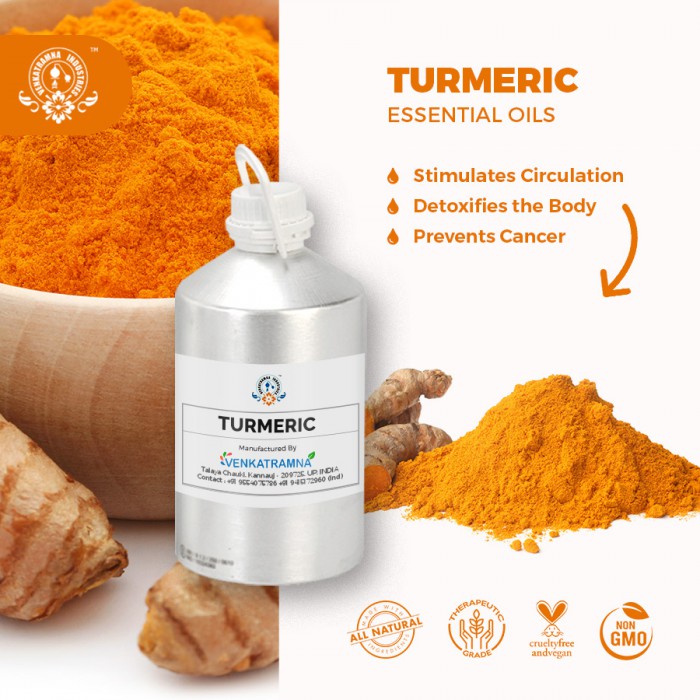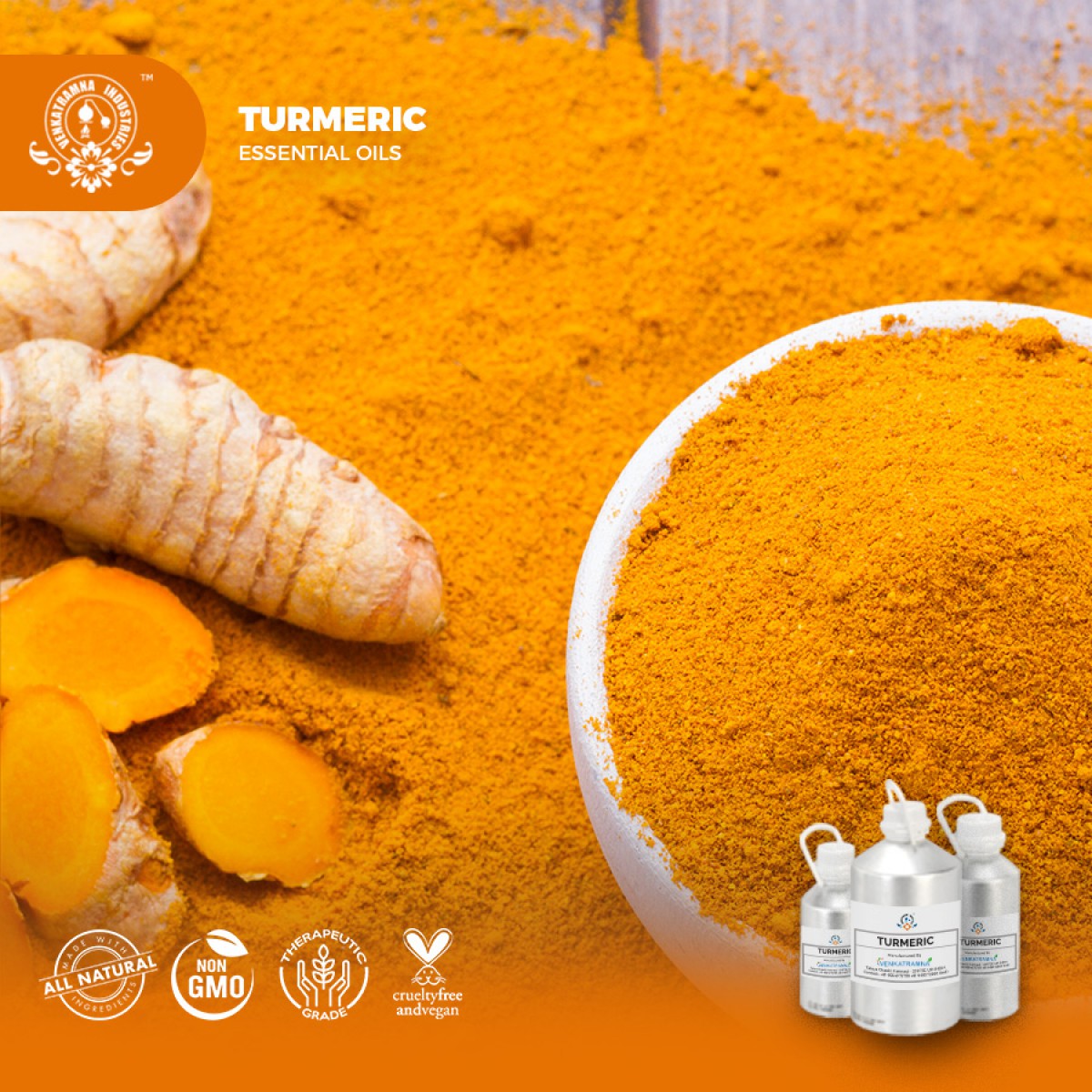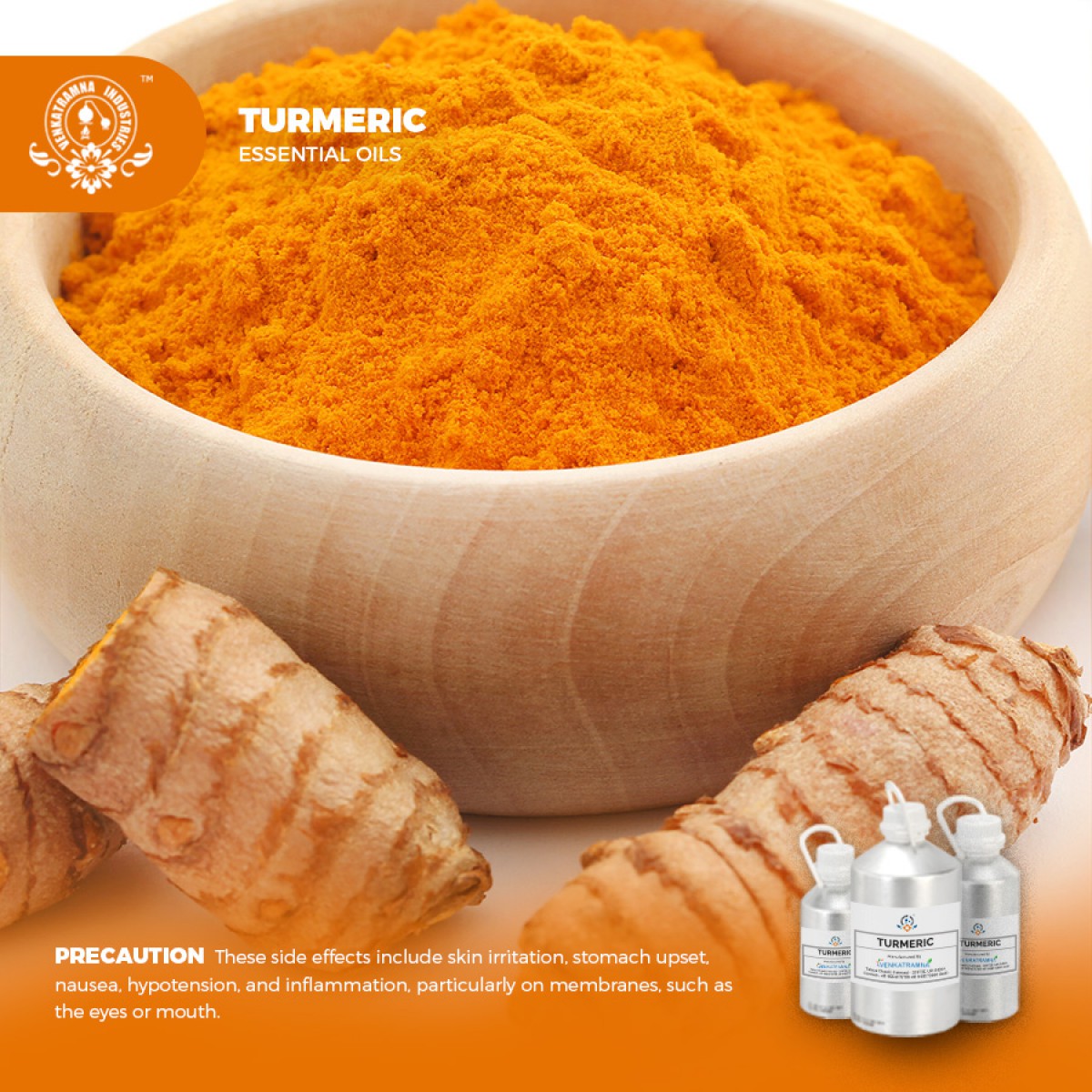Botanical Name: Curcuma longa Common name: Turmeric, Haldi Plant Read More
|
Botanical Name: |
Curcuma
longa |
|
Common name: |
Turmeric, Haldi |
|
Plant
family: |
Zingiberaceae |
|
Genus: |
Curcuma |
|
Appearance/Color: |
Pale yellow to
orange-yellow liquid. |
|
Odor: |
A base note with a medium
aroma, Turmeric Essential Oil has the same fragrant woody scent as the
powdered spice used in Eastern cuisine. |
|
Blends With: |
Ginger,
Clove Bud, Cinnamon Bark, Nutmeg and Clary Sage |
|
Origin: |
India |
|
Source: |
Rhizomes |
|
Method
of Extraction: |
Steam
Distillation |
Plants of ginger family
(Zingiberaceae) have been frequently and widely used as spices and in
traditional systems of medicine practiced in many Asian countries, and their
medicinal functions have been broadly discussed and accepted in many
traditional recipes. The Zingiberaceae plants contain several volatile and
essential oils including terpenoids, phenylpropanoids, flavonoids, and
sesquiterpenes, which has reported antitumour activity. As plants of
Zingiberaceae family are considered safe for human consumption, these species
are excellent candidates for development of novel chemotherapeutics.
Traditionally, curcuma drugs called “Ukon” and “Gajutsu” in Japanese have been
used in oketsu syndromes (caused by the obstruction of blood circulation) in
Chinese medicine. Various antineoplastic compounds have also been isolated from
curcuma species.
Curcuma longa, a medicinal
tuber plant belonging to this family, is a close relative of Curcuma
zedoaria from which the curcumin is isolated. Various parts of Curcuma are
used in Ayurveda and other folk and tribal system of medicines. The
rhizome is used for curing stomach diseases, toothache, blood stagnation,
leucoderma, tuberculosis, enlargement of spleen, and for promoting menstruation
in traditional medicine in Asia. Anti-inflammatory activity, antifungal
activity, antiulcer activity, antimicrobial effect, hepatoprotective activity,
antiamoebic effect, of this plant rhizome have been reported.
The use of turmeric dates back nearly 4000 years to the Vedic culture in India, where it was used as a culinary spice and had some religious significance. It probably reached China by 700 ad, East Africa by 800 ad, West Africa by 1200 ad, and Jamaica in the eighteenth century. In 1280, Marco Polo described this spice, marveling at a vegetable that exhibited qualities so similar to that of saffron. According to Sanskrit medical treatises and Ayurvedic and Unani systems, turmeric has a long history of medicinal use in South Asia. Susruta’s Ayurvedic Compendium, dating back to 250 bc, recommends an ointment containing turmeric to relieve the effects of poisoned food.
DISCLAIMER
The complete range of conditions
or methods of use are beyond our control therefore we do not assume any
responsibility and expressly disclaim any liability for any use of this
product. Information contained herein is believed to be true and accurate however,
all statements or suggestions are made without warranty, expressed or implied,
regarding accuracy of the information, the hazards connected with the use of
the material or the results to be obtained from the use thereof. Compliance
with all applicable federal, state, and local laws and local regulations
remains the responsibility of the user.
The FDA has not evaluated the
statements on this website. No claims are made by Venkatramna Industries as to
the medicinal value of any products from vriaroma.com or by us. The information
presented here is for educating our customers about the traditional uses of
essential oils and is not intended to diagnose, treat, cure, or prevent any
disease. You are responsible for understanding the safe application of these products.
If you have any questions, please call or email us for further information.
As per NAHA guidelines, New Directions Aromatics (NDA) does not recommend the ingestion of essential oils. It is imperative to consult a medical practitioner before using Essential Oils for therapeutic purposes. Pregnant and nursing women and those taking prescription drugs are especially advised not to use this product without the medical advice of a physician. The oil should always be stored in an area that is inaccessible to children, especially those under the age of 7.
Turmeric is a plant that has a very long history of medicinal
use, dating back nearly 4000 years. In Southeast Asia, turmeric is used not
only as a principal spice but also as a component in religious ceremonies. In
folk medicine, turmeric has been used in therapeutic preparations over the
centuries in different parts of the world. In Ayurvedic practices, turmeric is
thought to have many medicinal properties including strengthening the overall
energy of the body, relieving gas, dispelling worms, improving digestion,
regulating menstruation, dissolving gallstones, and relieving arthritis. Many
South Asian countries use it as an antiseptic for cuts, burns, and bruises, and
as an antibacterial agent. In Pakistan, it is used as an anti-inflammatory
agent, and as a remedy for gastrointestinal discomfort associated with
irritable bowel syndrome and other digestive disorders. In Pakistan and
Afghanistan, turmeric is used to cleanse wounds and stimulate their recovery by
applying it on a piece of burnt cloth that is placed over a wound. Indians use
turmeric, in addition to its Ayurvedic applications, to purify blood and remedy
skin conditions. Turmeric paste is used by women in some parts of India to
remove superfluous hair. Turmeric paste is applied to the skin of the bride and
groom before marriage in some parts of India, Bangladesh, and Pakistan, where
it is believed to make the skin glow and keep harmful bacteria away from the
body. Turmeric is currently used in the formulation of several sunscreens.
Several multinational companies are involved in making face creams based on
turmeric.
Turmeric is used as an herbal
medicine for rheumatoid arthritis, chronic anterior uveitis, conjunctivitis,
skin cancer, small pox, chicken pox, wound healing, urinary tract infections,
and liver ailments. It is also used for digestive disorders; to reduce flatus,
jaundice, menstrual difficulties, and colic; for abdominal pain and distension;
and for dyspeptic conditions including loss of appetite, postprandial feelings
of fullness, and liver and gallbladder complaints. It has anti-inflammatory,
choleretic, antimicrobial, and carminative actions. The main clinical targets
of turmeric are the digestive organs: in the intestine, for treatment of
diseases such as familial adenomatous polyposis; in the bowels, for treatment
of inflammatory bowel disease; and in the colon, for treatment of colon cancer.
Turmeric has been put to use as a
foodstuff, cosmetic, and medicine. It is widely used as a spice in South Asian
and Middle Eastern cooking. It lends curry its distinctive yellow color and
flavor. It is used as a coloring agent in cheese, butter, and other foods. As a
result of Indian influence, turmeric has made its way into Ethiopian cuisine.
In South Africa, turmeric is traditionally used to give boiled white rice a
golden color. Turmeric is also used in manufactured food products such as
canned beverages, dairy products, baked products, ice cream, yellow cakes,
yogurt, orange juice, biscuits, popcorn, sweets, cake icings, cereals, sauces,
and gelatins. It is a significant ingredient in most commercial curry powders.
Turmeric has numerous uses in Asian cuisine. It is used in savory and sweet
dishes and is widely used in Eastern specialties such as fresh turmeric
pickle.
COMMON
USAGE
·
Lowers inflammation
·
Prevents cancer
·
Stimulates circulation
·
Detoxifies the body
·
Boosts immune system
·
Improves digestion
·
Hair care
·
Skin care
·
Improves allergic response
·
Boosts cognitive function
·
Improves heart health
Ingredients:
|
S.No |
Key Constituents |
Strength (%) |
|
1 |
Turmerone |
8.0-28.4 |
|
2 |
Ar-turmerone |
15.5-27.5 |
|
3 |
Zingiberene |
11.6-16.8 |
|
4 |
a-phellandrene |
0.7-12.8 |
|
5 |
b-sesquiphellandrene |
8.8-9.5 |
|
6 |
Ar-curcumene |
2.8-.3 |
|
7 |
1,8-cineole |
0-6.9 |
|
8 |
b-curcumene |
0-5.6 |
|
9 |
Carlone |
0-4.9 |
|
10 |
a-caryophyllene |
0-3.9 |
|
11 |
Terpinolene |
0-3.9 |
|
12 |
b-bisabolene |
1.8-2.2 |
|
13 |
b-caryophyllene |
0.2-2.0 |
|
14 |
p-cymene |
0.3-1.4 |
Safety Summary
·
Hazards drug interaction
·
Cautions (oral) Diabetes medication
Organ Specific Effects
·
Adverse skin reaction: Undiluted turmeric rhizome oil was
slightly irritating to rabbits, but was not irritating to mice; tested at 4% on
25 volunteers it was neither irritating nor sensitizing. It is non-phototoxic.
·
Cardiovascular Effects: A turmeric
oil with 45.0–58.0% ar-turmerone dose-dependently inhibited glucosidase enzymes
more effectively than the antidiabetic drug acarbose.
Systemic Effects
·
Acute
Toxicity: Non-toxic.
Turmeric rhizome oil acute oral LD50 in rats >5 g/kg; acute dermal LD50 in
rabbits >5 g/kg.
·
Carcinogenic/anti carcinogenic potential: Turmeric
rhizome oil was markedly antimutagenic against sodium azide in the Ames test,
and showed a possibly related antioxidant activity. Turmeric rhizome oil was
active against human mouth epidermal carcinoma cells and mouse leukemia cells,
with respective IC50 values of 1.088 and 0.084 mg/mL. Turmeric rhizome oil
contains no known carcinogens. b-Sesquiphellandrene, ar-turmerone and
a-caryophyllene display anticarcinogenic activity.
·
Subchronic toxicity, human Turmeric
rhizome oil was orally administered to eight volunteers at 0.2 mL 3 times daily
for one month, followed by 1.0 mL per day in three divided doses for 2 further
months. One developed a rash on the trunk on the second day; this became worse
on the seveth day, and the volunteer dropped out of the study. The rash
subsequently resolved. In the remaining seven volunteers, compared to baseline
measurements, there were no significant changes in heart rate, blood pressure,
body weight, hematological tests liver function tests or kidney function tests.
In lipid profile testing, six volunteers showed no change in fasting sugar,
cholesterol, triglycerides, HDL or LDL. In one volunteer, tricglycerides and
LDL were normal at 4 weeks, but elevated at 12 weeks. Levels had returned to
normal one month after discontinuing the turmeric oil. There was no change in
the menstrual pattern of the three female volunteers. The turmeric oil used in
this study contained 59% turmeroneþar- turmerone, and 25% zingiberene.
·
Antioxidant/pro-oxidant activity Turmeric
rhizome oil has demonstrated significant antioxidant and DPPH radical
scavenging activity. The essential oil counteracted oxidative stress in rats,
reducing ROS in brain tissue.
·
Drug interactions Antidiabetic
medication, because of cardiovascular effects, above.
·
Acute aquatic toxicity: Not determined
·
Persistence and degradability: Not
available.
·
Bioconcentration Factor: Not determined
·
Mobility in soil: Not available.
·
Results of PBT and vPvB assessment: Not
determined
Do not allow the material to enter streams, sewers or other
waterways.





 PS-Turmeric.pdf
PS-Turmeric.pdf




